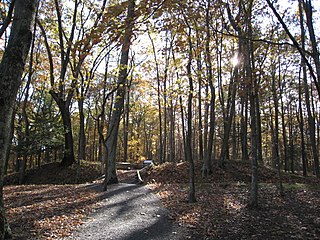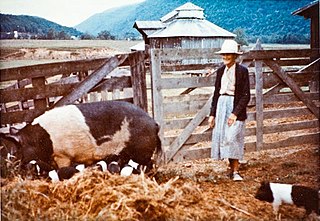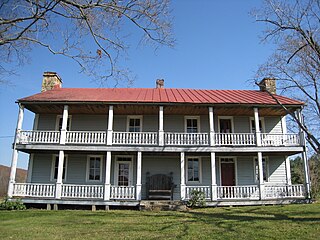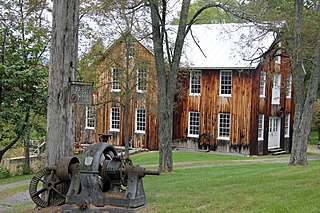
Pendleton County is a county located in the U.S. state of West Virginia. As of the 2010 census, the population was 7,695, making it the fifth-least populous county in West Virginia. Its county seat is Franklin. The county was created by the Virginia General Assembly in 1788 from parts of Augusta, Hardy, and Rockingham Counties and was named for Edmund Pendleton (1721–1803), a distinguished Virginia statesman and jurist. Pendleton County was strongly pro-Confederate during the American Civil War; however, there were pockets of Unionists who supported the state government in Wheeling.

Franklin is a town in Pendleton County, West Virginia, United States. The population was 721 at the 2010 census. It is the county seat of Pendleton County. Franklin was established in 1794 and named for Francis Evick, an early settler.

The South Branch Potomac River has its headwaters in northwestern Highland County, Virginia near Hightown along the eastern edge of the Allegheny Front. After a river distance of 139 miles (224 km), the mouth of the South Branch lies east of Green Spring in Hampshire County, West Virginia where it meets the North Branch Potomac River to form the Potomac.

The Sloan–Parker House, also known as the Stone House, Parker Family Residence, or Richard Sloan House, is a late-18th-century stone residence near Junction, Hampshire County, in the U.S. state of West Virginia. It was built on land vacated by the Shawnee after the Native American nation had been violently forced to move west to Kansas following their defeat at the Battle of Point Pleasant in 1774. The building was added to the National Register of Historic Places on June 5, 1975, becoming Hampshire County's first property to be listed on the register. The Sloan–Parker House has been in the Parker family since 1854. The house and its adjacent farm are located along the Northwestern Turnpike in the rural Mill Creek valley.

The Fort Mill Ridge Civil War Trenches are battle trenches in West Virginia that were originally dug between 1861 and 1862 to be later used in 1863 for the civil war. These trenches lined with chestnut logs by the Confederate artillery during the American Civil War to defend the approaches to Romney on the Northwestern Turnpike and the South Branch Potomac River. The trenches were then refurbished between March and June 1863 by the 54th Pennsylvania Infantry and the 1st West Virginia Infantry. When Colonel Jacob M. Campbell garrisoned Union forces at Romney, camps were set up at nearby at Mechanicsburg Gap. The Confederates might have created these trenches but all throughout the war the Union had control of these trenches.

Germany Valley is a scenic upland valley high in the Allegheny Mountains of eastern West Virginia originally settled by German farmers in the mid-18th Century. It is today a part of the Spruce Knob-Seneca Rocks National Recreation Area of the Monongahela National Forest, although much ownership of the Valley remains in private hands.

Ridgedale is a 19th-century Greek Revival plantation house and farm on a plateau overlooking the South Branch Potomac River north of Romney, West Virginia, United States. The populated area adjacent to Washington Bottom Farm is known as Ridgedale. The farm is connected to West Virginia Route 28 via Washington Bottom Road.

The Shepherdstown Historic District comprises the historic core of Shepherdstown, West Virginia. The town is the oldest in West Virginia, founded in 1762 as Mecklenburg. No structures are known to exist from the time before the town became known as Shepherdstown. The historic district is concentrated along German Street, the main street, with 386 contributing resources and 69 non-contributing elements. The chief representative period is the late 18th century, with many Federal style brick houses. German Street is also furnished with 19th-century "street furniture" such as metal fences, mounting blocks, wooden pumps and mature trees.

The Conrad Shindler House is a historic building, now home to the George Tyler Moore Center for the Study of the Civil War, in Shepherdstown, West Virginia.

The Kuykendall Polygonal Barn was an early 20th-century polygonal barn in the South Branch Potomac River valley near Romney in Hampshire County, West Virginia. The Kuykendall Polygonal Barn was the only 15-sided barn built in West Virginia, and one of only a few such known to have been constructed in the United States. The barn utilized a number of sophisticated technological innovations not found in West Virginia's other round and polygonal barns. The Kuykendall Polygonal Barn was listed on the National Register of Historic Places on 9 July 1985.

Hook Tavern is a late 18th-century tavern along the Northwestern Turnpike east of Capon Bridge in Hampshire County, West Virginia. It was listed on the National Register of Historic Places on April 29, 2011.
McCoy House, McCoy Farmhouse, McCoy Farm or variations may refer to:

The McCoy House, also known as Franklin Town Office or Pendleton County Library, is a historic home located at Franklin, Pendleton County, West Virginia. It was built in 1848, and is a two- to three-story, "L"-shaped, brick building in the Greek Revival-style. It features a one bay entrance portico with two sets of double Ionic order columns. A three-story porch is incorporated into the northeastern section.

This is a list of the National Register of Historic Places listings in Clay County, Kentucky.

Priest Mill is a historic sawmill and early electric power plant located near Franklin, Pendleton County, West Virginia. It was built in 1900, with an addition built in 1916 to house a generator and hydro-electric power plant. Electric power was generated at the mill starting in 1911, and in 1913, the Priest's home became the first in Pendleton County to have electric lights. It replaced a mill that was destroyed by fire in 1899. It is a three-story, "T"-shaped, unadorned wooden structure. Originally covered with wood shingles, the roof was later replaced with metal. The mill race measures 988 feet from the headgates at the dam to the entrance under the mill. It operated as a wool carding mill until the 1950s, and reopened in the 1980s.

Franklin Historic District is a national historic district located at Franklin, Pendleton County, West Virginia. The district encompasses 111 contributing buildings, mostly residences. It also includes the central business district, much of it rebuilt after a fire in 1924. Most of the residences are in the Queen Anne or American Foursquare style, with commercial Greek Revival and Italianate-style buildings. Notable buildings include an early 19th-century, stuccoed stone farmhouse and barn, five Queen Anne style dwellings, and the Pendleton County Court House (1924-1925). Also located in the district is the separately listed McCoy House.

Valley View is a mid-19th-century Greek Revival residence and farm overlooking the South Branch Potomac River northwest of Romney, West Virginia. The house is atop a promontory where Depot Valley joins the South Branch Potomac River valley.

Old Pine Church, also historically known as Mill Church, Nicholas Church, and Pine Church, is a mid-19th century church located near to Purgitsville, West Virginia, United States. It is among the earliest extant log churches in Hampshire County, along with Capon Chapel and Mount Bethel Church.

Ananias Pitsenbarger Farm is a historic home and farm complex located at Franklin, Pendleton County, West Virginia. The original section of the house was built in 1845, and includes the 2 1/2-story section on the north end, with a later 1 1/2-story addition built about 1900. The house rests on a foundation of coursed rubble stone and is clad in weatherboard siding. It has a standing-seam metal gable roof. Also on the property are 15 log and frame contributing outbuildings. They include the cellar house, two hog pens, a stable, woodworking shop, carriage house, chicken coop, granary, shed, privy constructed by the Works Progress Administration, spring house, three small hay barns, and a large double-crib log hay barn. Also on the property is the Pitsenbarger Cemetery.
The Pendleton Times is a newspaper serving Franklin, West Virginia, and surrounding Pendleton County. Published weekly, it has a circulation of 4,226 and is owned by Pendleton Times LLC.




















